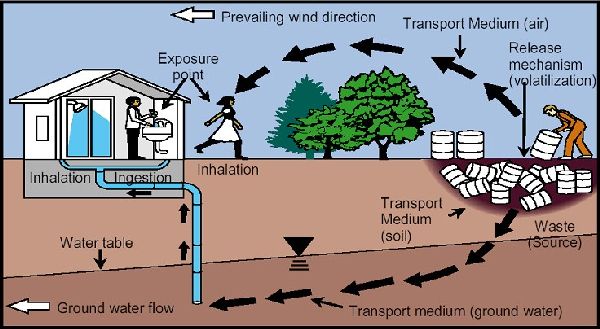Human Health Risk Assessment
What is it?
A Human Health Risk Assessment is the method of determining the probability of harm occurring to people from exposure to contaminants at a site. Both the toxic properties of hazardous substances and the ways that people may be exposed to these substances are evaluated.
What is the process?
The risk assessment process has four basic steps:
- Identify the hazardous substances found on the site and at what levels.
- Identify the ways people might be exposed to these chemicals (exposure pathway) and at what levels they are being exposed (dose), both of which can be used to develop a conceptual site model. Breathing vapors, eating or drinking, and skin contact are the main exposure routes considered during risk assessment.
- Identify potential health risk from exposure to these chemicals by examining both the carcinogenic and non-carcinogenic effects.
- Use information from the first three steps to evaluate and summarize the risks associated with each chemical found at the site.
Glossary
- exposure pathway
- the course a hazardous substance takes from a source to the body. A hazardous substance can have more than one exposure pathway.
- noncarcinogen
- a substance that is not known to cause cancer, but may have effects, such as headaches, skin burning, etc.
- carcinogen
- a substance that can cause or induce cancer.
Example of a Conceptual Site Model.
What is a Conceptual Site Model?
The conceptual site model is a three-dimensional drawing, or flow chart, that shows how contaminants at a site could reach people and identify who may be at risk. The model may be modified throughout the investigation as more information becomes available.
Why Do We Do It?
A risk assessment helps determine whether significant risks to peoples’ health may exist at or near a contaminated site and also helps determine a risk-based cleanup level for the site.
A risk assessment is one factor project managers use to make decisions on how a contaminated site should be cleaned up. Other factors include state and federal regulations, costs, treatment techniques and their feasibility, and community acceptance.
Risk Management
Once an assessment identifies the potential health risks associated with a contaminated site, steps can be taken to manage those risks. If a significant health risk is identified, steps can be taken to protect workers on the site and nearby residents from harmful exposure. Because it is not always practical, feasible or necessary to remove all contamination from a site, a risk assessment can be used to determine appropriate cleanup levels that ensure the site is safe for its intended purpose.
References
- DEC Contaminated Sites Remediation Program, Risk Assessment Procedures Manual.
- DEC Oil and Hazardous Substances Pollution Control Regulations.
- EPA Superfund Risk Assessment web page.
- EPA Superfund activities for kids.
Have more questions? Visit the Contaminated Sites Program's Contact page to get in touch.
This fact sheet is one of a series of free publications prepared by DEC to help people understand contaminated site cleanup issues. The others can be found at Contaminated Sites FAQ (alaska.gov).


 Indicates an external site.
Indicates an external site.